Removable Mandibular Expander (Schwartz)
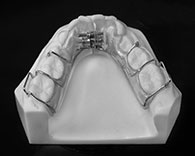 The Schwartz Appliance is a removable expansion appliance primarily used on
the lower arch in order to expand the arch and create needed additional
space for the permanent teeth. Treatment time in the Schwartz Appliance is
approximately nine months, but will vary based on individual needs of the
patient. If both the upper and lower arches require expansion, we may use
the Schwartz along with a Rapid Palatal Expander in order to coordinate the
expansion of both arches.
The Schwartz Appliance is a removable expansion appliance primarily used on
the lower arch in order to expand the arch and create needed additional
space for the permanent teeth. Treatment time in the Schwartz Appliance is
approximately nine months, but will vary based on individual needs of the
patient. If both the upper and lower arches require expansion, we may use
the Schwartz along with a Rapid Palatal Expander in order to coordinate the
expansion of both arches.
Reverse Pull Headgear/Protraction Facemask
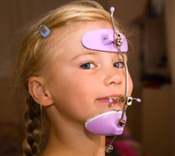 Headgear is often used to correct an excessive overbite. This is done by
placing pressure against the upper teeth and jaw, which would hold the teeth
in position or help move them into better positions. The severity of the
problem determines the length of time headgear needs to be worn. The key to
success with your headgear appliance is consistency. Headgear must be worn a
certain number of hours per day, and if not, it must be made up the
following day.
Headgear is often used to correct an excessive overbite. This is done by
placing pressure against the upper teeth and jaw, which would hold the teeth
in position or help move them into better positions. The severity of the
problem determines the length of time headgear needs to be worn. The key to
success with your headgear appliance is consistency. Headgear must be worn a
certain number of hours per day, and if not, it must be made up the
following day.
Headgear should never be worn while playing sports and should also be removed while eating or brushing your teeth.
Separators
Separators are small elastics that fit snugly between certain teeth to move them slightly so bands can be placed around them later. Separators can fall out on their own if enough space has already been created. To determine if it needs to be replaced, slip some dental floss between the teeth; if it gets stuck, that means the separator hasn't created enough room and needs to be replaced prior to your banding appointment.
Space Maintainer
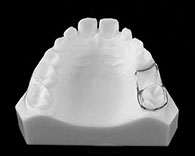 Space maintainer keeps the vacated space open until the permanent tooth is
ready to come in. Not every tooth that is lost too early requires a space
maintainer. If one of the four upper front teeth is lost early, the space
will stay open on its own until the permanent tooth comes in.
Space maintainer keeps the vacated space open until the permanent tooth is
ready to come in. Not every tooth that is lost too early requires a space
maintainer. If one of the four upper front teeth is lost early, the space
will stay open on its own until the permanent tooth comes in.
A space maintainer is made of stainless steel and/or plastic. Some space maintainers are removable, which fixed space maintainers are cemented into the patient's mouth.
There are two general types of space maintainers:
- Removable Space Maintainers
- Fixed Space Maintainers
TADs
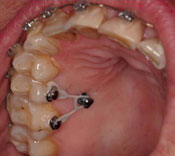 One of the many important advances in orthodontics has been the
development of temporary anchorage devices, or TADs. Made of a
bio-compatible titanium alloy, TADs are miniscrew anchors which are inserted
into specific places in the mouth to be used as a fixed point from which
teeth can move. Before TADs, orthodontists who wanted to move some teeth
while keeping others still, or to achieve orthodontic movement in a mouth
with missing teeth, had to rely on headgear for their fixed point. But TADs
now provide an option for that fixed point that is smaller, more discreet,
more efficient and requires significantly less work for the patient.
One of the many important advances in orthodontics has been the
development of temporary anchorage devices, or TADs. Made of a
bio-compatible titanium alloy, TADs are miniscrew anchors which are inserted
into specific places in the mouth to be used as a fixed point from which
teeth can move. Before TADs, orthodontists who wanted to move some teeth
while keeping others still, or to achieve orthodontic movement in a mouth
with missing teeth, had to rely on headgear for their fixed point. But TADs
now provide an option for that fixed point that is smaller, more discreet,
more efficient and requires significantly less work for the patient.
Temporary anchorage devices may not be recommended for everyone, and in fact, anchorage devices at all may not be needed in all cases. Contact us if you'd like to know more about TADs and how they can potentially prevent you from needing orthodontic headgear.
Thumb/Finger Appliance
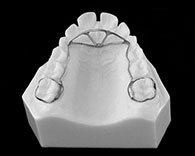
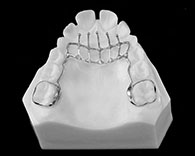
Sucking is a natural reflex that relaxes and comforts babies and toddlers. Children usually cease thumb sucking when the permanent front teeth are ready to erupt. Typically, children stop between the ages of 2 and 4 years. Thumb sucking that persists beyond the eruption of primary teeth can cause improper growth of the mouth and misalignment of the teeth. If you notice prolonged and/or vigorous thumb sucking behavior in your child, talk to your dentist.
One solution to thumb sucking is an appliance called a "fixed palatal crib." This appliance is put on the child's upper teeth by an orthodontist. It's placed behind the upper teeth on the roof of the mouth. The crib consists of semicircular stainless steel wires that are fastened to molars using steel bands. The stainless steel wires fit behind the child's upper front teeth, and they are barely visible. The crib usually stops the habit of thumb sucking within the first day of use.
Upper Tongue Crib
A tongue crib is used to help break bad habits such as tongue thrusting and thumb sucking by retraining the tongue. The crib is a metal appliance that is attached to your upper teeth by fixed bands. It has a block, or a gate, that prevents your tongue from moving forward.
Tongue thrusting can cause an overbite by pushing your front teeth forward. If you are a tongue thruster, the crib retrains your tongue to not touch the front teeth. Thumb sucking can cause an open bite. If your child sucks his/her thumb, the crib blocks the thumb from being inserted.
To have enough time for the tongue to be retrained and the bad habit terminated, the tongue crib is usually left in place for six months to a year.
Locations
- MON - THU9:00 am - 5:00 pm
- FRIClosed
- SAT8:45 am - 1:00 pm
- SUNClosed
- MON - THU9:00 am - 5:00 pm
- FRIClosed
- SAT8:45 am - 1:00 pm
- SUNClosed
